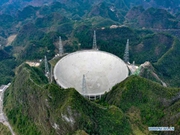

 |
| The phase-1 project of the central route of the South-North Water Diversion Project has been maintained safe operation for 2,000 days as of June 3, diverting 30 billion cubic meters of water. (People’s Daily Online/Chen Huaping) |
After over 2,100 days of operation, the central route of the South-North Water Diversion Project, a mega infrastructure project of China, has transferred 30 billion cubic meters of water, and benefitted more than 67 million people.
The route, sending water from the Danjiangkou Reservoir located in the upper and middle reach of the Hanjiang River, the largest tributary of the Yangtze River, to Henan, Hebei, Tianjin and Beijing, stretches a total length of 1,432 kilometers.
The mega project couldn't have been built without constant ecological conservation at the water sources. The water source region of the central route of the South-North Water Diversion Project covers 49 counties (prefectures and districts) in 6 provinces, totaling 95,000 square kilometers. Since the project was launched in 2005, the water sources of the project have been well protected, and sound ecological environment has been maintained.
When the project just kicked off, only 20 of the 42 sections evaluated in the Danjiangkou Reservoir and its upper reaches met water quality standard, and some even failed to meet Grade V standard, the lowest in China’s classification.
After the operation of the project, all sections have met standard. According to the latest total water quality test, all 109 indicators fell into the category of the Grade II standard, and 95 percent of the routine indicators met the standard of Grade I. The water fetched 15 meters below the surface in the project’s reservoirs is drinkable.
In the past, desertification prevailed around the reservoirs, because of which the sands and dirt were always brought to the reservoirs and turned clean water turbid. At present, the forest coverage in Henan's Nanyang and Hubei's Shiyan, where the reservoirs locate, stands at 40.5 percent and 66.7 percent, respectively.
The improved ecology also lifted biodiversity. Today, in the reservoir regions live over 800 terricolous vertebrates that are of economic and research value, including 53 under state priority conservation. These regions are also home to 170 migrant birds and a number of valuable plants.
Scaly-sided merganser, a species listed as endangered in the International Union for Conservation of Nature Red List of Threatened Species, have been spotted spending the winter in Shiyan Huanglongtan National Wetland Park for 6 years in a row. Peach blossom jellyfish, nicknamed “panda in the water”, is also frequently observed there.
The industrial structure in the reservoir regions was simple and extensive, relying heavily on natural resources. Now, after restructuring the agriculture, organic fertilizers are applied to crops. Besides, high-pollution and high energy consuming enterprises have been shut down, moved away or transferred, and an environmentally friendly industrial system is taking shape. The improved environment has led to booming local tourism, attracting numerous visitors and constantly expanding the service industry for local communities.
The enhanced ecological conservation efforts not only have no impacts on local people’s livelihood, but also steadily increase their income. Farmers nowadays are living in well-built houses, in which they have bought fridges and TVs and have access to clean water, kitchens and bathrooms. “Without the South-North Water Diversion Project, there would be no such drastic changes in the reservoir regions,” said local people and cadres.
 |

 Award-winning photos show poverty reduction achievements in NE China's Jilin province
Award-winning photos show poverty reduction achievements in NE China's Jilin province People dance to greet advent of New Year in Ameiqituo Town, Guizhou
People dance to greet advent of New Year in Ameiqituo Town, Guizhou Fire brigade in Shanghai holds group wedding
Fire brigade in Shanghai holds group wedding Tourists enjoy ice sculptures in Datan Town, north China
Tourists enjoy ice sculptures in Datan Town, north China Sunset scenery of Dayan Pagoda in Xi'an
Sunset scenery of Dayan Pagoda in Xi'an Tourists have fun at scenic spot in Nanlong Town, NW China
Tourists have fun at scenic spot in Nanlong Town, NW China Harbin attracts tourists by making best use of ice in winter
Harbin attracts tourists by making best use of ice in winter In pics: FIS Alpine Ski Women's World Cup Slalom
In pics: FIS Alpine Ski Women's World Cup Slalom Black-necked cranes rest at reservoir in Lhunzhub County, Lhasa
Black-necked cranes rest at reservoir in Lhunzhub County, Lhasa China's FAST telescope will be available to foreign scientists in April
China's FAST telescope will be available to foreign scientists in April